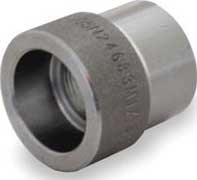Socket Weld fittings general
A Socket Weld is a pipe attachment detail in which a pipe is inserted into a recessed area of a Valve, fitting or flange. In contrast to buttweld fittings, Socket Weld fittings are mainly used for small pipe diameters (Small Bore Piping); generally for piping whose nominal diameter is NPS 2 or smaller.
To join pipe to Valves and fittings or to other sections of pipe, fillet-type seal welds be used. Socket Welded Joints construction is a good choice wherever the benefits of high leakage integrity and great structural strength are important design considerations.
Fatigue resistance is lower than that in butt-welded construction due to the use of fillet welds and abrupt fitting geometry, but it is still better than that of most mechanical joining methods.
Some details of Socket Weld fittings
SW Fittings are family of high pressure fittings are used in various industrial processes.
- They are used for lines conveying flammable, toxic or expensive material where no leakage can be permitted, and for steam 300 to 600 PSI.
- They are used only in conjunction with ASME Pipe and are available in the same size range.
- They are used in areas where pipe-work is permanent and are designed to provide good flow characteristics.
- They are are produced to several ASTM standards and are manufactured in accordance with ASME B16.11. The B16.11 standard covers pressure-temperature ratings, dimensions, tolerances, marking, and material requirements for forged carbon and alloy steel. Acceptable material forms are forgings, bars, seamless pipe, and seamless tubes which conform to the fittings chemical requirements, melting practices, and mechanical property requirements of ASTM A105, A182, or A350.
- They are available in three pressure ratings: Class 3000, 6000 and 9000.
TYPES OF SOCKET WELD FITTINGS BY CLASS, SIZE AND WALL THICKNESS

Description | Class Designation | ||
3000 | 6000 | 9000 | |
Elbows 45 and 90 degrees, | 1/2 - 4 | 1/2 - 2 | 1/2 - 2 |
1/2 - 4 | 1/2 - 2 | 1/2 - 2 | |
1/2 - 4 | 1/2 - 2 | 1/2 - 2 | |
Pipe Size | SCH 80 / XS | SCH 160 | XXS |
Plugs and Bushings are not identified.
They may be used up through Class 6000 NPS
Advantages and Disadvantages of Socket Weld fittings
ADVANTAGES
- The pipe need not be beveled for weld preparation.
- Temporary tack welding is no needed for alignment, because in principle the fitting ensures proper alignment.
- The weld metal can not penetrate into the bore of the pipe.
- They can be used in place of threaded fittings, so the risk of leakage is much smaller.
- Radiography is not practical on the fillet weld; therefore correct fitting and welding is crucial. The fillet weld may be inspected by surface examination, magnetic particle (MP), or liquid penetrant (PT) examination methods.
- Construction costs are lower than with butt-welded joints due to the lack of exacting fit-up requirements and elimination of special machining for butt weld end preparation.

DISADVANTAGES
- The welder should ensure for a expansion gap of 1/16 inch (1.6 mm) between de pipe and the shoulder of the socket.
ASME B31.1 para. 127.3 Preparation for Welding (E) Socket Weld Assembly says:
In assembly of the joint before welding, the pipe or tube shall be inserted into the socket to the maximum depth and then withdrawn approximately 1/16" (1.6 mm) away from contact between the end of the pipe and the shoulder of the socket. - The expansion gap and internal crevices left in socket welded systems promotes corrosion and make them less suitable for corrosive or radioactive applications where solids buildup at the joints may cause operating or maintenance problems. Generally require butt welds in all pipe sizes with complete weld penetration to the inside of the piping.
- Socket welding are unacceptable for UltraHigh Hydrostatic Pressure (UHP) in Food Industry application since they do not permit full penetration and leave overlaps and crevices that are very difficult to clean, creating virtual leaks.
The purpose for the bottoming clearance in a Socket Weld is usually to reduce the residual stress at the root of the weld that could occur during solidification of the weld metal, and to allow for differential expansion of the mating elements.
Fittings for Socket Weld Pipe systems
 |  |
FULL-COUPLING | HALF-COUPLING |
 |  |
REDUCING COUPLING | REDUCER INSERT |
 |  |
UNION (MSS SP-83) | ELBOW 90°
|
 |  |
ELBOW 45° | TEE STRAIGHT |
 |  |
CROSS | CAP (END CAP) |
|
|


